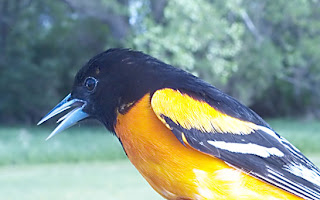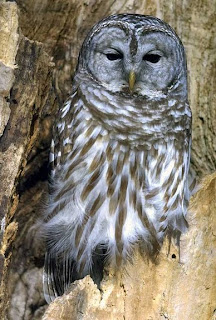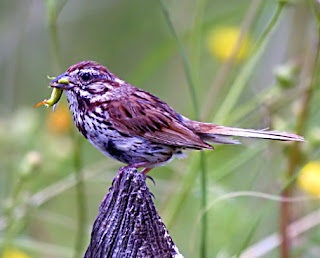Zones of Secondary Contact
A number of things happen in zones of secondary contact:
1) No interbreeding at all (or almost none). Eastern Meadowlark and Western Meadowlark are examples.
2) Low level hybridization (5-10 %) in low populations. It my be better to make it with anyone rather than nobody at all. Secondary areas of contact are usually at edge of optimum range for both species and birds don't live more than 1 or 2 years normally. Examples include Indigo Bunting and Lazuli Bunting and Golden-winged Warbler and Blue-winged Warbler.
3) A complete breakdown of isolating mechanisms with almost no pure birds in zone of secondary contact. For example, Audubon's Warbler and Myrtle Warbler are now called Yellow-rumped Warbler.
4) Same as 3 but with extensive genetic introgression into each population. For example, Yellow-shafted Flicker and Red-shafted Flicker (Northern Flicker): orange feather shafts are found well out of the expected ranges.
Hybrid Indexes are often constructed to study just what the situation is. In the early 1950's, Baltimore Oriole and Bullock's Oriole hybridized extensively in a study area in the Great Plains. You could draw a graph that showed pure Baltimore plumages on the left and pure Bullock's on the right. Most birds were a mixture of plumages, with the majority being about half and half. In 1973 a fellow went back to these localities and found selection against hybrids, most birds were pure. Apparently zones of secondary contact in the midwest are not stable. Check your field guide and see how these species are treated. Old books treat them as different species, books written in the 1980's consider them to be the same, and the most recent books treat them as different species.
Apparently people have caused many previously allopatric species to become sympatric--we have forested the Great Plains and created a broad front of contact. Birds that have come together include flickers, grosbeaks, and buntings.
By the way, sympatric speciation is possible. How might that happen? The little evidence we have for sympatric speciation in birds involves hybridization wherein the hybrids breed true rather than back to parental types.
1) No interbreeding at all (or almost none). Eastern Meadowlark and Western Meadowlark are examples.
2) Low level hybridization (5-10 %) in low populations. It my be better to make it with anyone rather than nobody at all. Secondary areas of contact are usually at edge of optimum range for both species and birds don't live more than 1 or 2 years normally. Examples include Indigo Bunting and Lazuli Bunting and Golden-winged Warbler and Blue-winged Warbler.
3) A complete breakdown of isolating mechanisms with almost no pure birds in zone of secondary contact. For example, Audubon's Warbler and Myrtle Warbler are now called Yellow-rumped Warbler.
4) Same as 3 but with extensive genetic introgression into each population. For example, Yellow-shafted Flicker and Red-shafted Flicker (Northern Flicker): orange feather shafts are found well out of the expected ranges.
Hybrid Indexes are often constructed to study just what the situation is. In the early 1950's, Baltimore Oriole and Bullock's Oriole hybridized extensively in a study area in the Great Plains. You could draw a graph that showed pure Baltimore plumages on the left and pure Bullock's on the right. Most birds were a mixture of plumages, with the majority being about half and half. In 1973 a fellow went back to these localities and found selection against hybrids, most birds were pure. Apparently zones of secondary contact in the midwest are not stable. Check your field guide and see how these species are treated. Old books treat them as different species, books written in the 1980's consider them to be the same, and the most recent books treat them as different species.
Apparently people have caused many previously allopatric species to become sympatric--we have forested the Great Plains and created a broad front of contact. Birds that have come together include flickers, grosbeaks, and buntings.
By the way, sympatric speciation is possible. How might that happen? The little evidence we have for sympatric speciation in birds involves hybridization wherein the hybrids breed true rather than back to parental types.
At various times, Baltimore Orioles (above)
and Bullock's Orioles have been considered to be the same species





Comments
Post a Comment